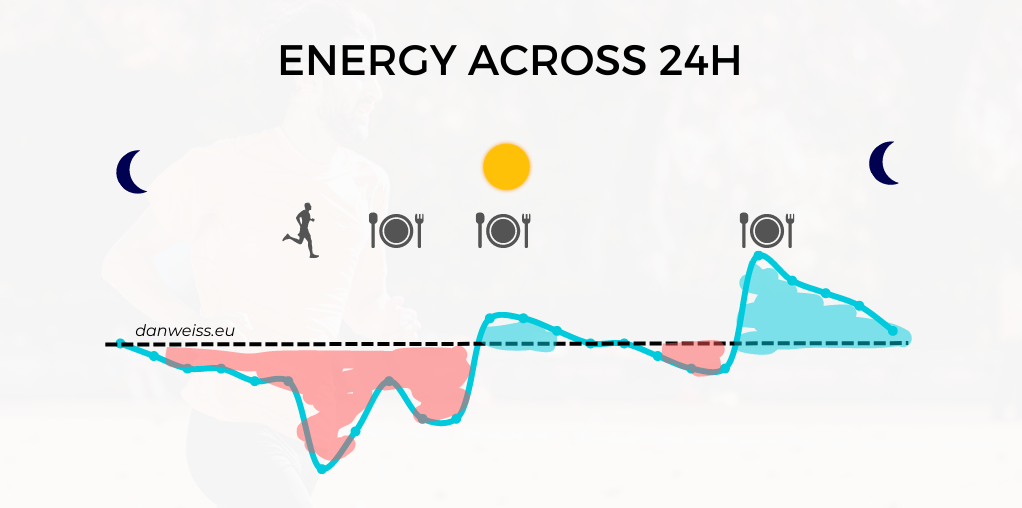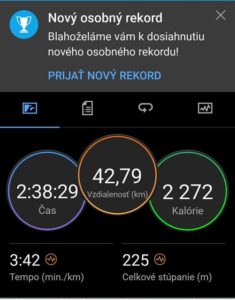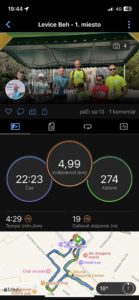Inadequate fueling. RED-S
Athletes and active individuals wanting to maximize their performance and those pursuing aesthetic goals can restrict their energy intake too much. At first, they will lose weight, which leads to better performance but if practiced chronically as it is common in endurance and weight-based sports, it will lead to health problems.
In this comprehensive article you will discover:
- what Relative Energy Deficiency is
- who is at risk
- the symptoms and consequences of RED-S
The typical signs of inadequate fueling include:
- Your performance during training is lower despite giving it your all
- Gradual loss of performance
- Stagnation in training
- Delayed recovery between training sessions
- Skipping or missing menstrual cycle (Female athlete triad)
- The body holds onto more fat
- Disturbed sleep
- Fatigue throughout the day
- Cravings in the evenings (especially sweets cravings)
- No motivation for training
If you spot multiple of these signs, there is a good chance you are underfueling.
Low Energy Availability
For the body to function properly, it requires energy, which we have in limited quantities. If it doesn’t have enough, it obtains it from fat stores. This is sufficient during periods of low activity and inactivity, but even a slow run requires multiple times more energy per hour than walking or sitting at a desk.
Energy Intake vs. Relative Energy Intake
Energy intake represents the total energy intake over the course of a day. Relative energy intake shows how much energy the body has on an hourly basis throughout the day.
Total available energy is partitioned between different systems in the body:
Cellular maintenance
Movement
Thermoregulation
Reproduction
Growth
What happens to your body during chronically low energy availability?
The body fuels activities of the highest energy demand first. During periods of low energy availability, you can still have energy for training, but your body’s systems start to shut down as a result of low energy availability. An athlete in training with high expenditure and low energy intake can hinder his/her health if energy availability stays low for an extended period of time.
That is when athletes start to notice the negative consequences.
-
Body creates a lower setpoint weight
-
Lower metabolic rate, which makes athletes frustrated and they eat less to lose fat!!!
-
Thyroid functions lowered (sex steroid pathways, IGF-1)
-
Muscle loss due to lower Muscle Protein Synthesis(IGF-1) and higher protein breakdown (Muscle oxidative capacity stays the same)
-
Cortisol up (fat storage, bad body composition)
-
Digestion problems, IBS
-
Lower peak power
-
Low performance and recovery
-
Bone density loss (lowered bone turnover)
-
Amenorrhea
How low energy intake is too low?
For a person training 5+ times a week it’s estimated to be <45kcal / kg of lean body mass.
An 80kg male ultra runner with 15% body fat:
- Eats 2250 kcal
- Weighs 80kg, 68kg of lean body mass
- Spends 700kcal running training
2250 -700 = 1550kcal
1550kcal /68kg = 22.8kcal/kg!
His body has 1550 kcal to live, repair, play with kids, and teach fitness classes…
Who is at risk?
Although until recently RED-S was more often observed in the female population, it was partially because men did not receive enough attention.
While a female can notice skipping or missing the menstrual cycle as a quick sign of low energy availability, the male’s body does not react as quickly.
Low Energy Availability
-
Conscious decision – usually to lose weight
- Psychological problems like body image and disordered eating issues
Unintentional
-
Lack of knowledge about proper nutrition and nutritional sources to fuel properly,
-
Lack of time to prepare meals
-
Lack of skills in preparing meals
-
Financial reasons
-
Physiological reasons like loss of appetite after training due to suppression of ghrelin production
A survey of eating habits and nutrition knowledge among amateur ultrarunners showed that the participants (308) had low nutrition knowledge. They also found that their diet and nutrition knowledge were not necessarily related to achieving specific sporting outcomes. “They often strain to higher levels of energy expenditure, which they then cover with unhealthy snacks and other unhealthy products.” (Kosendiak A et. al.)
Psychological aspects of underfueling
The psychological aspect is also important and I deal with it mainly in personal work with clients, because each person is psychologically very different.
In general, there are several dysfunctional patterns of thinking that athletes have.
“It’s only 10km, that doesn’t even count as training.”
Whether you consider running 10 km as training or not, the fact remains that you had to spend energy on it. Just because running 10km now seems easier compared to when you started with running, it doesn’t mean you’re not spending energy.
“Today I have a day off and I should eat less.”
If you are active outside of training, e.g. you walk 10,000 steps, or you have a job where you are physically active, you are expending energy. This energy expenditure can easily exceed the energy expended during training.
In addition, the training volume during the week should be taken into account. If you train e.g. 9 hours or more a week, you don’t need to eat enough calories and carbs. Therefore, limiting food during rest days can lead to insufficient energy intake in the context of whole week.
“Unless I’m training hard, I don’t need as much energy.”
You may not feel this way, but you can burn more energy during light activity than during intense training. This is mainly because we cannot train at high intensity for long. On the other hand, we can walk for hours and not feel exhausted. Evaluating the activity in terms of intensity is not at all beneficial. (see table below)
In the table, you will find an example of the energy expenditure of 70 kg (154 lbs) runner who runs 10 km (6.2mi).
| Pace (min per km) | min per mile | Energy expenditure |
| 6:00 | 9:39 | 720 |
| 5:30 | 8:51 | 741 |
| 5:00 | 8:03 | 698 |
| 4:30 | 7:14 | 678 |
| 4:00 | 6:26 | 627 |
The data in the table is based on https://caloriesburnedhq.com/calories-burned-running/ and your individual expenditure may vary. The table serves to illustrate the principle.
After intense strength training, people usually feel hungry. After intense cardio, quite the opposite. Here you need to look at the facts, not just the feelings.
Carbohydrates seem to be important to prevent RED-S
Carbohydrates fuel performance, but they also seem to have an association with RED-S.
Some studies even found that low-carb diets elicited small negative effects on athletes’ iron levels, immune functions, and response to exercise, but no substantial alterations to athlete health were observed when athletes restricted energy availability with sufficient carbohydrates. The authors concluded that “Short-term restriction of CHO, rather than energy, may have greater negative impacts on athlete health.” (source)
Poor chronic CHO availability, beyond or instead of LEA (low Energy Availability), is emerging as a potential mechanism also associated with some RED-S related outcomes (source)
Many athletes don’t eat enough carbohydrates
There are several reasons why athletes try to eat carbs with the problem of eating enough carbs. Some are physiological, some mental.
However, if your appetite is low, it may be due to exercise-induced stress or suboptimal food choices.
Typical cases are vegans, but also people who try to eat healthily. Their diet is dominated by vegetables, whole grains, lean meats, nuts, and legumes. While such a diet is undoubtedly healthy and helps to lose weight and subsequently maintain weight, it prevents people with high energy demands from getting sufficient energy.
Legumes, vegetables, whole grains are full of fiber, which is essential for the satiety and the health of the digestive tract.
In addition, vegetables are low in calories. Therefore, an athlete with a high energy expenditure should not have diet centered around vegetables but rather look at higher-calorie sources of healthy nutrients.
Lean meat provides high-quality proteins, but at the same time, it can feel heavy for an athlete. Excessive protein intake is also not a benefit if it prevents the athlete from consuming sufficient total energy and carbohydrates. Quantity is essential! You do not need to eat 400g of chicken breast 3 times a day. 100g of chicken breast contains approx. 30g of protein.
If we eat a diet high in fibre and protein, we will struggle to take in enough calories and carbohydrates. Therefore, it is necessary to look at the diet during the day and at times close to training differently.

When you eat matters
Did you know that you can take in enough calories to support your training within a day but still stagnate, feel heavy, or even get into the RED state? If you want to feel energetic and light, it is important what foods you eat and when you eat them.
Having enough energy around the training is especially important for female athletes! Clinically, it is called relative energy deficit or RED-S, which manifests itself mainly in athletes with high energy expenditure and insufficient energy intake.
Dietary practices like Intermittent Fasting can lead athletes to insufficient energy intake. Endurance athletes have high energy expenditure, and getting an adequate amount of energy in a shortened time frame is impractical. Large portions can cause digestive discomfort, and training on an empty stomach can lead to health problems.
For example, consider a runner who trains in the morning on an empty stomach:
- When we don’t eat, the body draws energy from fats. In the morning, we start in an energy deficit, which the body covers from fat stores.
- They go for a 15 km run on an empty stomach, which requires about 750 kcal.
- Afterward, they have breakfast (400 kcal). This means they are in a deficit of 350 kcal. This deficit will increase throughout the day.
They only achieve a positive energy balance after a light lunch. This means that until then, the body is breaking down because it doesn’t have energy for repair and growth. - By evening, they are already too hungry, which leads to overeating.
According to research, active women who spend more time in a deficit of >300 kcal have a slower metabolism, less muscle mass, and reproductive health problems. This was true even when they had the same total energy intake at the end of the day!
Not sure if you are fueling enough?
If you want to get a better overview of your health, you have the option of testing blood biomarkers:
- Cortisol – increased levels of cortisol
- Testosterone – usually reduced
Vitamin D - T3 – is directly linkedto energy and carbohydrate availability
- Ferritin (iron stores). A typical problem of endurance athletes,especially women, vegans and vegetarians.
- Inflammatory markers – in runners, they are usually manifested by painful joints and repetitive injuries.
These markers will give you a better overview of your nutritional and physiological status and where your health is trending e.g. reduced low ferritin levels will show up before you have reduced hemoglobin – at which point athletes tend to be chronically fatigued.
What is the root cause of these conditions?
Too much stress (physical and mental) and reduced availability of energy (little food).
Therefore, if you take your training seriously, you should also take your rest and diet seriously.
Fueling best practices:
- Eat 3-6 times a day – smaller meals are digested more quickly and make you feel lighter.
- Include pre-workout snacks if your training is more than 4 hours after your main meal.
- Fuel during sessions longer than 60 minutes.
- If you had no pre-workout, and after training, you have more than an hour till your next meal, include postworkout protein and carbs, ideally in a 1:3 ratio. (banana and a scoop of protein)
- Don’t skip breakfast, even if your workout is in the evening.
- If you are training hard for 10 or more hours a week, then don’t limit carbs on your rest days. – you have relatively high physical activity, even if it doesn’t feel hard.
What if you want to lose weight?
To lose weight, you need to create a caloric deficit. But how you create it matters.
REMEMBER:
Your body is constantly optimizing:
- How much energy it spends;
- What it spends energy on;
Only if you give your body enough energy, at the right time you will be healthy, build muscle, think quickly, and lose fat easily. That is why performance is a better indicator than a number on the scale.
Female bodies are more prone to energy disturbances within the day than male bodies.
Underfueling and low energy availability have different root causes. A lack of education, in psychology, to physiology. Often they are interconnected and so all the areas need to be considered in recovery.
Whether you are a pro or a hobby athlete, give your body the energy it needs, when it needs it, and see PBs happen!

Michal – Professional ultra runner we work with on his nutrition.

Hanka – Amateur runner who keeps improving even a year after our collaboration🙂
Learn how to best fuel your body
If you want to learn how to best fuel your body, stop tracking your food and meet with Daniel who specializes in sports nutrition and can help you create a sustainable diet/food plan that fits your unique needs and lifestyle.
- Click the link below
- Fill-in the intake form
- Wait for my email to schedule a strategy call. I reply within 24 hours.
Looking forward to hear from you,
Daniel
Additional Resources
- Mountjoy M, Ackerman KE, Bailey DM, Burke LM, Constantini N, Hackney AC, Heikura IA, Melin A, Pensgaard AM, Stellingwerff T, Sundgot-Borgen JK, Torstveit MK, Jacobsen AU, Verhagen E, Budgett R, Engebretsen L, Erdener U. 2023 International Olympic Committee’s (IOC) consensus statement on Relative Energy Deficiency in Sport (REDs). Br J Sports Med. 2023 Sep;57(17):1073-1097. doi: 10.1136/bjsports-2023-106994. PMID: 37752011.
- Kosendiak A, Król M, Ligocka M, Kepinska M. Eating habits and nutritional knowledge among amateur ultrarunners. Front Nutr. 2023 Jul 10;10:1137412. doi: 10.3389/fnut.2023.1137412. PMID: 37497055; PMCID: PMC10365969.
- Jagim AR, Fields JB, Magee M, Kerksick C, Luedke J, Erickson J, Jones MT. The Influence of Sport Nutrition Knowledge on Body Composition and Perceptions of Dietary Requirements in Collegiate Athletes. Nutrients. 2021 Jun 29;13(7):2239. doi: 10.3390/nu13072239. PMID: 34209814; PMCID: PMC8308384.
